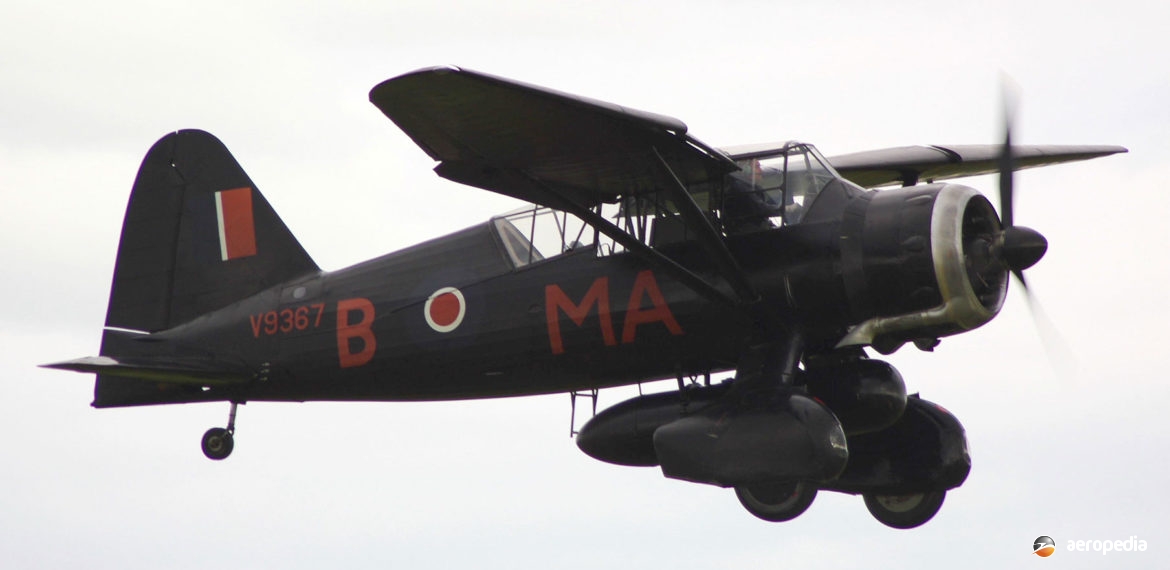Photograph:
Westland Lysander V9367 / G-AZWT at Duxford in the United Kingdom in July 2012 (David C Eyre)
Country of origin:
United Kingdom
Description:
Two-seat army co-operation monoplane
Power Plant:
One 664 kw (890 hp) Bristol Mercury XII nine-cylinder air-cooled radial engine
Specifications:
- Wingspan: 15.24 m (50 ft)
- Length: 9.30 m (30 ft 6 in)
- Height: 3.54 m (11 ft 6 in)
- Wing area: 24.5 m² (260 sq ft)
- Max speed at sea leve:l 332 km/h (206 mph)
- Max speed at 4,575 m (15,000 ft): 359 km/h (223 mph)
- Cruising speed: 241 km/h (150 mph)
- Stalling speed: 88 km/h (55 mph)
- Initial rate of climb: 503 m/min (1,650 ft/min)
- Time to 4,575 m (15,000 ft): 11.4 mins
- Service ceiling: 7,923 m (26,600 ft)
- Range: 966 km (600 miles)
- Empty weight: 1,844 kg (4,065 lb)
- Loaded weight: 3,402 kg (7,500 lb)
Armament:
One 7.7 mm (0.303 in) fixed Browning machine gun firing forward in each wheel spat; one 7.7 mm (0.303 in) Lewis Mk III or Vickers K gun in mounting in rear fuselage; provision to carry supply packs etc on mountings under wings and bombs under rear fuselage
History:
In 1934 under the direction of W E W Petter, to meet specification 39/34, a design team at Westland Aircraft in Somerset produced the Lysander, the prototype of which (K6127) was flown on 15 June 1936 with a 627 kw (840 hp) Bristol Mercury IX engine in the hands of Harald Penrose, Chief Test Pilot for Westland Aircraft. After being fitted with a three-blade variable pitch propeller, it made its public debut at Hendon in Greater London on 27 June.
Production aircraft began to be delivered from the Company’s Yeovil facility, also in Somerset, in May 1938, and five Army Co-operation Squadrons were formed in the United Kingdom and one in Egypt. Eventually, production changed from the Mk I to the Mk II, this having a 675 kw (905 hp) Bristol Perseus engine, a shorter chord engine cowling and no blister fairings over the rocker boxes.
Whilst with the British expeditionary force in France the Lysander squadrons suffered severe losses, with 50 aircraft shot down and another 30 lost on the ground due to direct and indirect enemy action.
In August 1940 the Mk III was introduced with the 649 kw (870 hp) Mercury Mk XX or Mk 30 engine, but otherwise differed little from the Mks I and II, a number being delivered as target tugs. Total production was two prototypes and 1,447 aircraft built by Westland in the United Kingdom and 225 in Canada.
After withdrawal from front line service they were operated on communications duties. In Europe the Lysander became known for covert operations when, fitted with long-range fuel tanks, they were used to deliver and retrieve agents from fields on the Continent.
No 208 Squadron RAF received 24 Mk Is at Heliopolis in Egypt in November 1938, and No 6 Squadron received 24 at Ramleah in Palestine, which aircraft fought in the western desert extensively, but were very vulnerable to enemy fighters if no fighter escort was available.
No 3 Squadron RAAF was formed on 1 July 1925 and was equipped with de Havilland DH.9s, DH.9As and RAF SE.5As, having three flights, each having a different task: army co-operation, bombing and fighter. In 1940 the unit was ordered overseas, at that time operating Westland Wapitis and Hawker Demons. It sailed for Egypt in July to operate in the army co-operation role from Ismailia in Egypt, being equipped with aircraft then available in the area, including examples of the Westland Lysander, Gloster Gauntlet and Gloster Gladiator. Soon after the Lysanders were deployed to Lkingi Mariut and the other aircraft to Gerawla, both in Egypt. The Squadron took up tactical reconnaissance duties but by the end of that year was only flying Gladiators, the surviving Lysanders being returned to the RAF.
Some 18 Lysanders are known to survive, six in airworthy condition.

